Developmental Psychology - Week 9
1/33
Earn XP
Description and Tags
Moral Development
Name | Mastery | Learn | Test | Matching | Spaced |
|---|
No study sessions yet.
34 Terms
Prosocial behaviour
Any voluntary, intentional action that produces a positive or beneficial outcome for the recipient, regardless of whether that action is costly to the donor, neutral in its impact, or beneficial.
Categories of prosocial behaviour
Carlo (2006) proposed 6 categories of prosocial tendencies: altruistic tendencies, dire tendencies, emotional tendencies, public tendencies, anonymous tendencies, and compliant tendencies.
Altruistic tendencies
Refers to the natural inclination to help others and act in their best interests, often without expecting anything in return. This involves feelings of empathy and compassion, and it is influenced by social upbringing and personal experiences.
Dire tendencies
Refers to harmful inclinations, such as selfishness, aggression, or dishonesty. These behaviors can lead to actions that disregard the well-being of others and conflict with moral values.
Emotional tendencies
Refers to the feelings and emotions that influence a person's understanding of right and wrong. These can include empathy, guilt, shame, and compassion.
Public tendencies
Refers to how individuals engage in actions that benefit others, and how these actions are influenced by public visibility, social norms, and the expectations of others.
Anonymous tendencies
Refers to how individuals engage in helping or altruistic actions without seeking recognition or being identified. This means people are more motivated by internal factors such as empathy and moral values.
Compliant tendencies
These are the actions that individuals engage in to conform to social expectations, rules, or requests from others, often driven by a desire to avoid negative consequences or to gain approval.
Benefits of prosocial behaviour (McGuire, 1994)
Enhances reputation and self-esteem., development of empathy - cognitive and affective, internalization of socially acceptable norms.
The development of prosocial behaviour
Various factors in the family and school environments influence the development of prosocial behaviour; reinforcement, punishment for not being helpful, modeling, moral exhortation - preaching, encouraging.
The parent-child relationship
Parents who are empathetic (score highly on perspective-taking tasks) and who respond sensitively to their children’s needs are more likely to have children who are high in empathy towards others.
Securely attached children demonstrate more empathy toward their peers.
Children who are regularly encouraged to reflect on the consequences of their behaviour and its effect on others are more likely to show empathy and demonstrate more prosocial behaviour.
Internalisation of parental values
Grusse and Goodnow (1994) internalisation of parental and prosocial values happens in two stages:
Child’s accurate perception of the parent’s message of prosocial values.
Acceptance of those values.
What factors contribute to prosocial behavioural development - siblings
Experiences with siblings are important in promoting prosocial behaviour.
This has implications for the emergence of sensitivity and empathy towards others.
The growth of social understanding develops through balancing preoccupation with self against responsiveness to others’ feelings and needs.
Prosocial behaviour and the peer group
Young people with a reciprocated best friend are more likely to be protected from aggressive acts of social exclusion by peers. (Boulton et al., 1999)
Children are motivated to help each other against peer difficulties in the context of reciprocated friendship.
Vulnerable young people can be protected by befriending interventions, however, in the absence of such appropriate interventions the peer group cannot be relied upon to act prosocially.
Prosocial behaviour and the school environment
In order to foster prosocial behaviour in educational settings, teachers must incorporate values of trust of trust and co-operation into the whole school , and not simply “teach” prosocial behaviour as series of separate lessons.
Peer support systems
Many forms of peer support systems used by schools to supplement the work of pastoral.
Three broad approaches:
Befriending/mentoring schemes
Mediation/conflict schemes
Counselling
Sex differences in prosocial behaviour
Gender differences in prosocial behaviour in preschoolers - It is widely believed that girls are more prosocial than boys.
But the large discrepancy between observational and experimental findings suggests gender differences found in empirical studies are due to conformity to gender stereotypes rather than actual behaviour and emotions.
Cultural differences
Quite wide variations in the value of prosocial behaviour and altruism by different cultural groups.
More prosocial cultures where women’s contribution to the family economy was highest - These women delegated more responsibility to their children, giving them opportunities to develop their prosocial behaviour.
Cultures that place high value on individual success are more likely to foster competitiveness than cooperation in their children.
Do children co-operate?
The Warneken et al. (2010) study explored the development of altruism and moral behavior in young children (around 2 years old). The research showed that children often engage in spontaneous helping behaviors, such as assisting adults without being asked or rewarded, indicating early signs of altruism. However, the study also found that children’s helping was influenced by social context and expectations, suggesting they understand social norms around helping. The research highlighted the role of both innate altruistic tendencies and social learning in shaping children's moral development. Social feedback and role models were also found to encourage prosocial behavior.
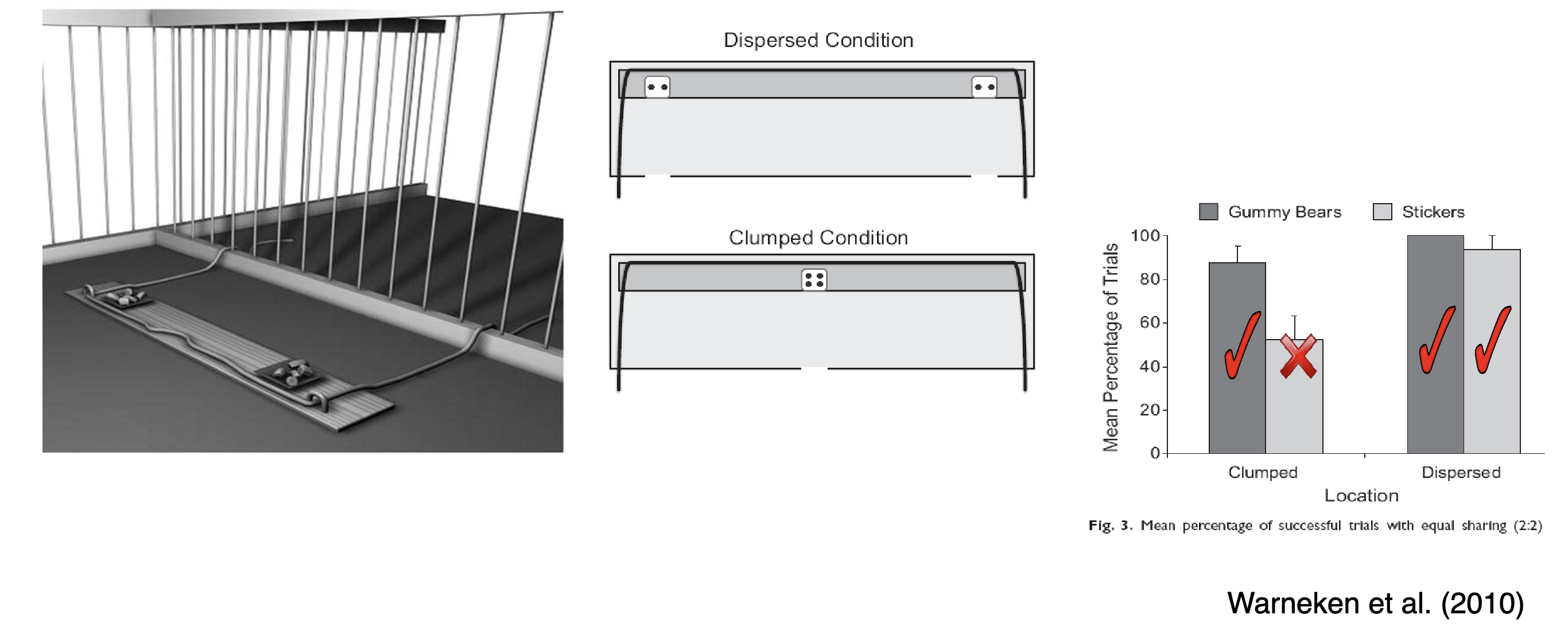
Do 18th month old children help adults?
The Warneken and Tomasello (2006) study focused on the emergence of altruistic helping behavior in young children. The researchers investigated whether 2-year-old children would help an adult in need, even without being asked or rewarded. The study found that children spontaneously helped adults in various situations, such as picking up dropped items, demonstrating early signs of altruism. These results suggested that young children possess an innate tendency to help others, challenging the idea that prosocial behavior only develops through explicit teaching or external rewards. The study emphasized that moral development includes early, spontaneous prosocial behaviors.
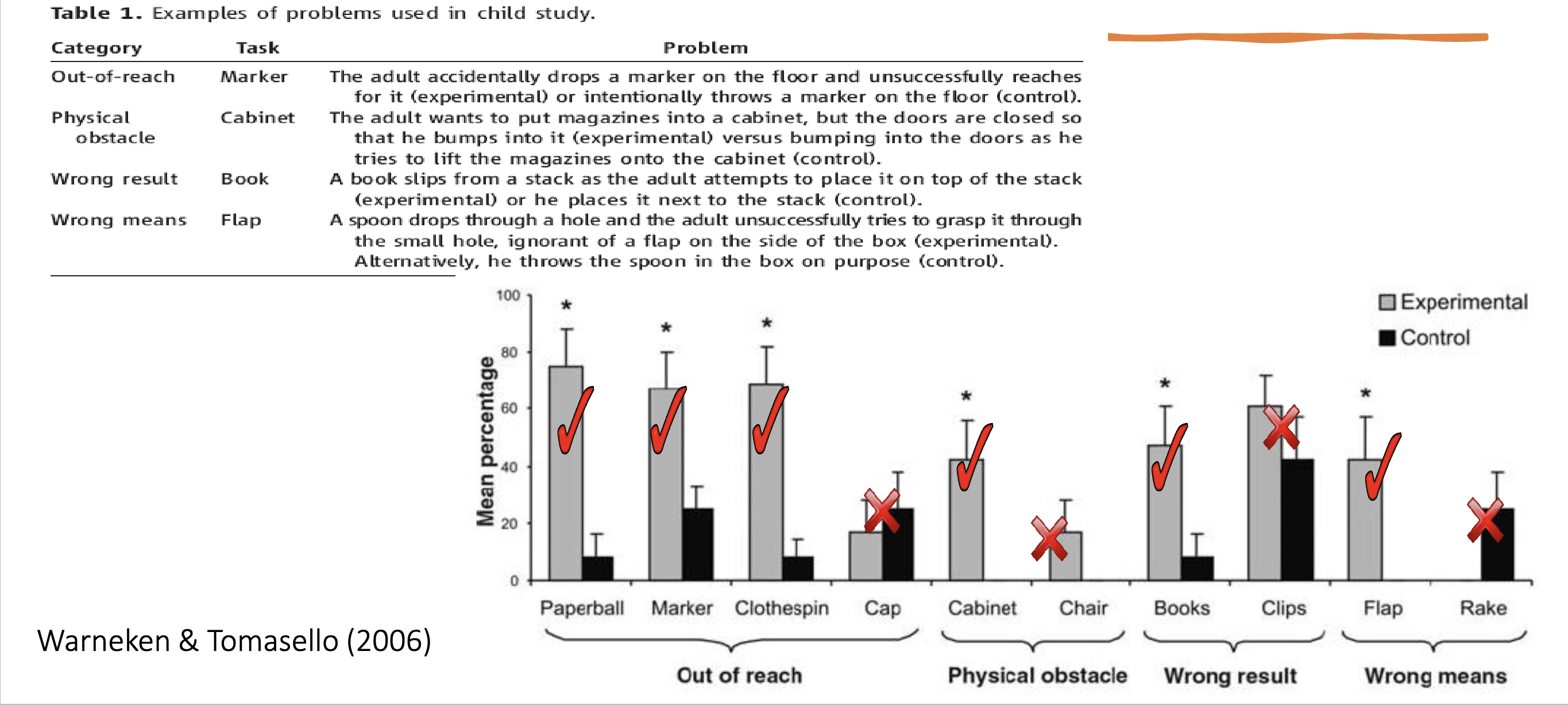
How do 3 to 8 year old children perform?
The House, Henrich, Brosnan, & Silk (2012) study explored the evolution of moral behavior in humans and primates. The researchers examined how cooperation and punishment function in social groups, focusing on how humans and non-human primates (like chimpanzees) engage in prosocial behavior and enforce social norms. The study found that humans have a unique capacity for third-party punishment, where individuals are willing to intervene and punish those who violate social norms, even when they are not directly affected. This suggests that human moral behavior is deeply tied to social cooperation and the enforcement of norms, playing a key role in moral development. The study highlights the role of group dynamics in shaping moral behavior across species.
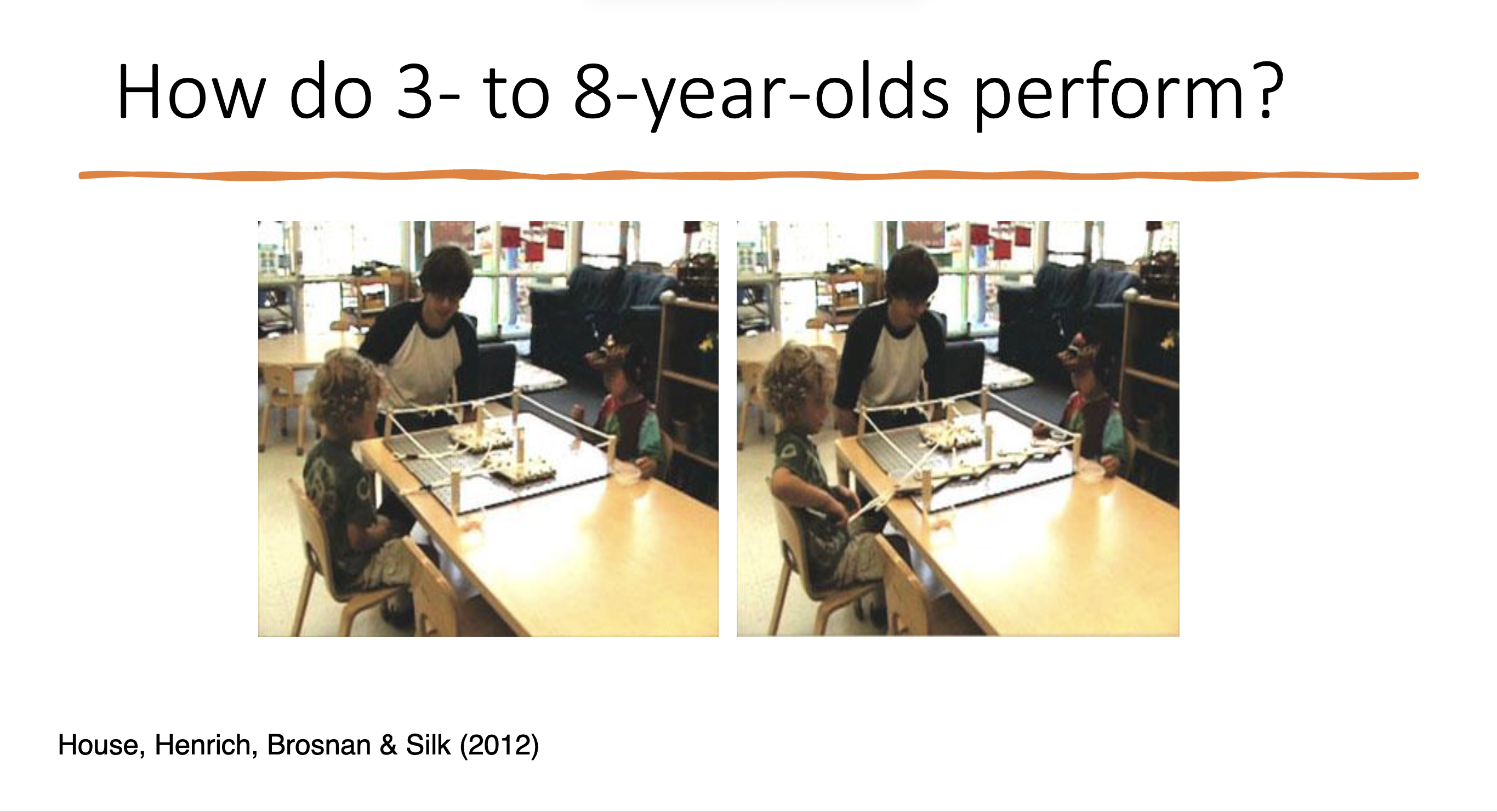
Three different reward distributions
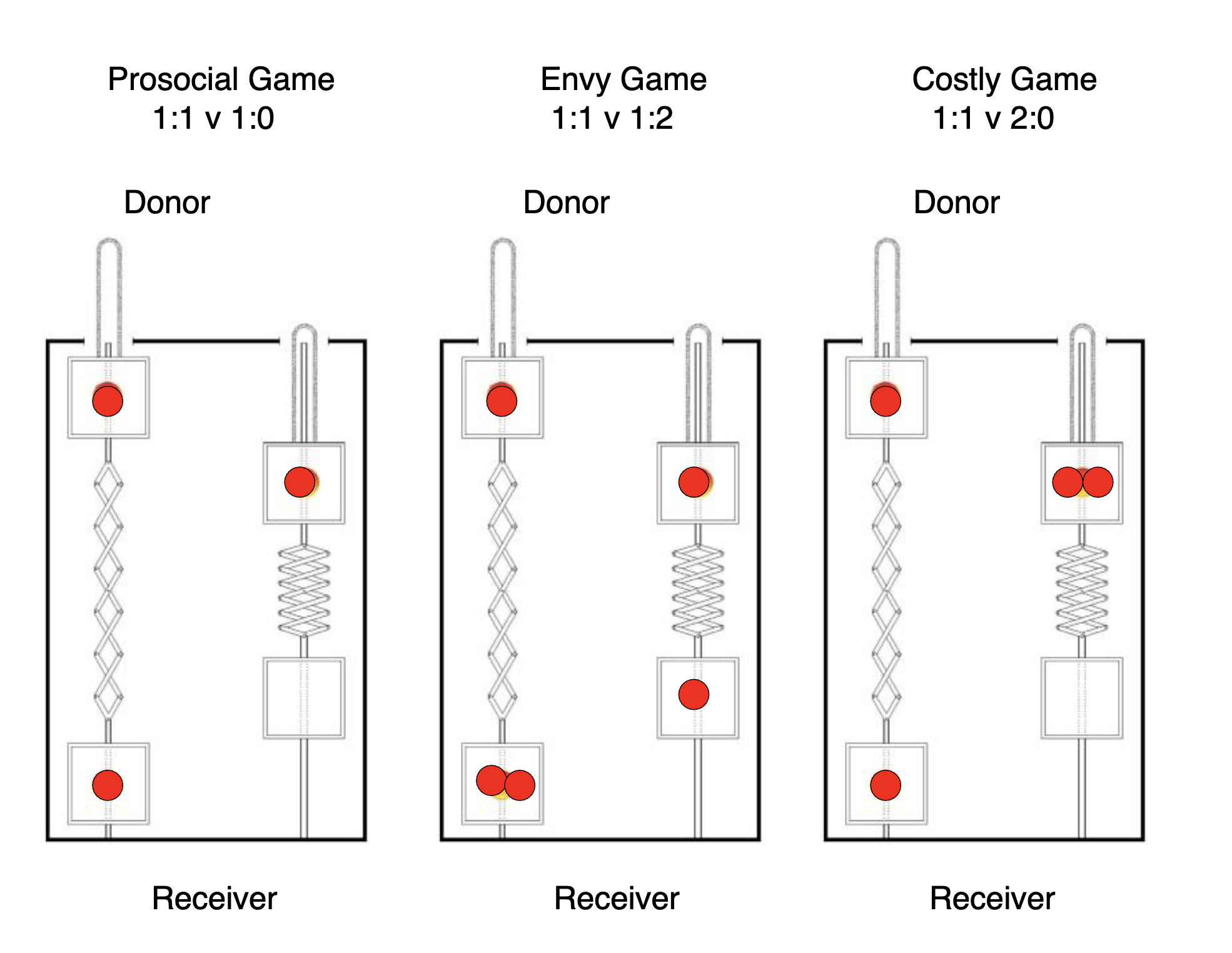
Are children generous in these games?
Overall, children were not very generous. In the prosocial game (black bars) children equally
likely to offer either a reward or nothing to their
partner.
However, children appear less willing to select an
option were both individuals receive a reward (1:1
option) rather than the 2:0 option where they
receive more themselves (grey bars).
Children appear reluctant to award a greater value reward to their partner (1:2 option) in the envy game (white bars). Choosing instead 1:1
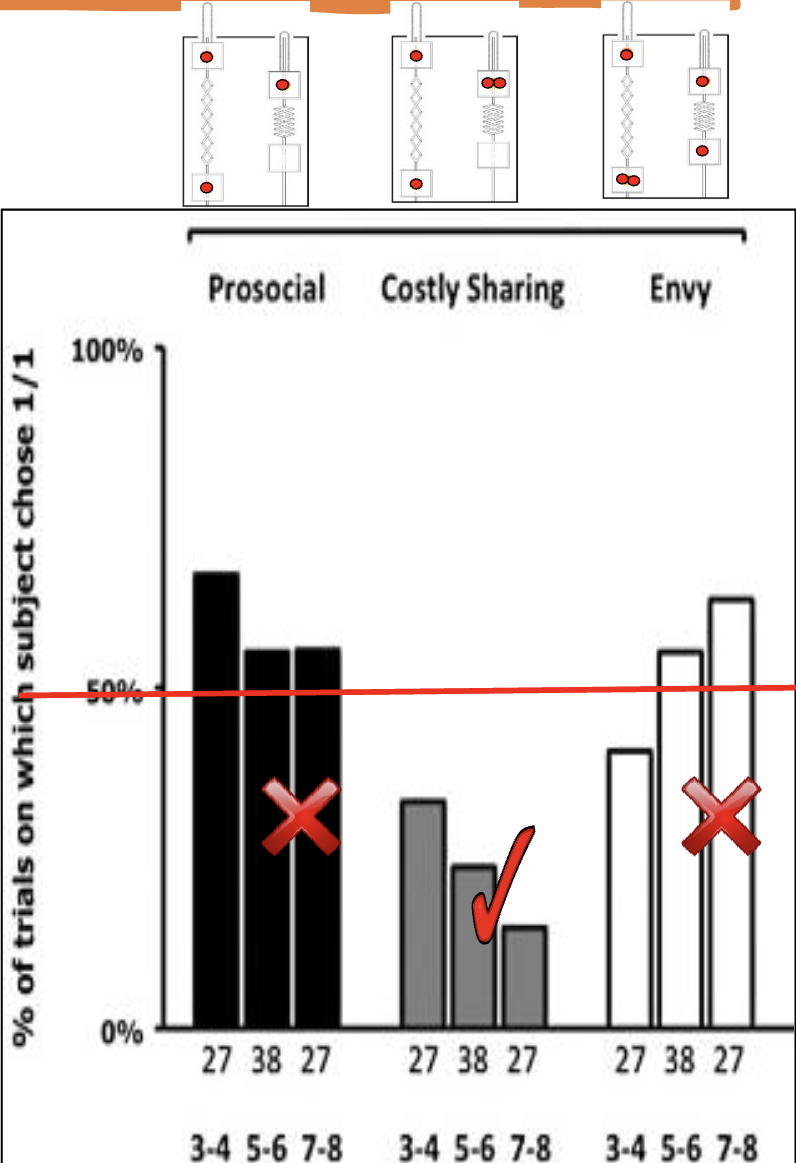
Are chimps prosocial in these tasks?
Key Findings:
Pro-social Behavior in Chimpanzees: The study found that chimpanzees did not consistently act prosocially in the tasks presented. In the experiment, one chimpanzee had the opportunity to help another by providing a tool or resource that the other chimpanzee needed to obtain a reward. However, the results showed that chimpanzees did not spontaneously help others unless there was a direct benefit to themselves.
Lack of Altruism: While the chimpanzees were cooperative in some situations (such as when cooperation provided mutual benefits), they did not engage in altruistic behavior (helping others with no personal gain). This suggests that chimpanzees are not inclined to help others unless there is a clear self-interest or immediate reward.
Cooperation with Immediate Benefits: In tasks where the chimpanzees could benefit directly from their cooperation (such as receiving food or other resources), they were more likely to engage in prosocial behavior. This suggests that chimpanzees may act cooperatively, but their motivation is rooted in self-interest rather than a true concern for the welfare of others.
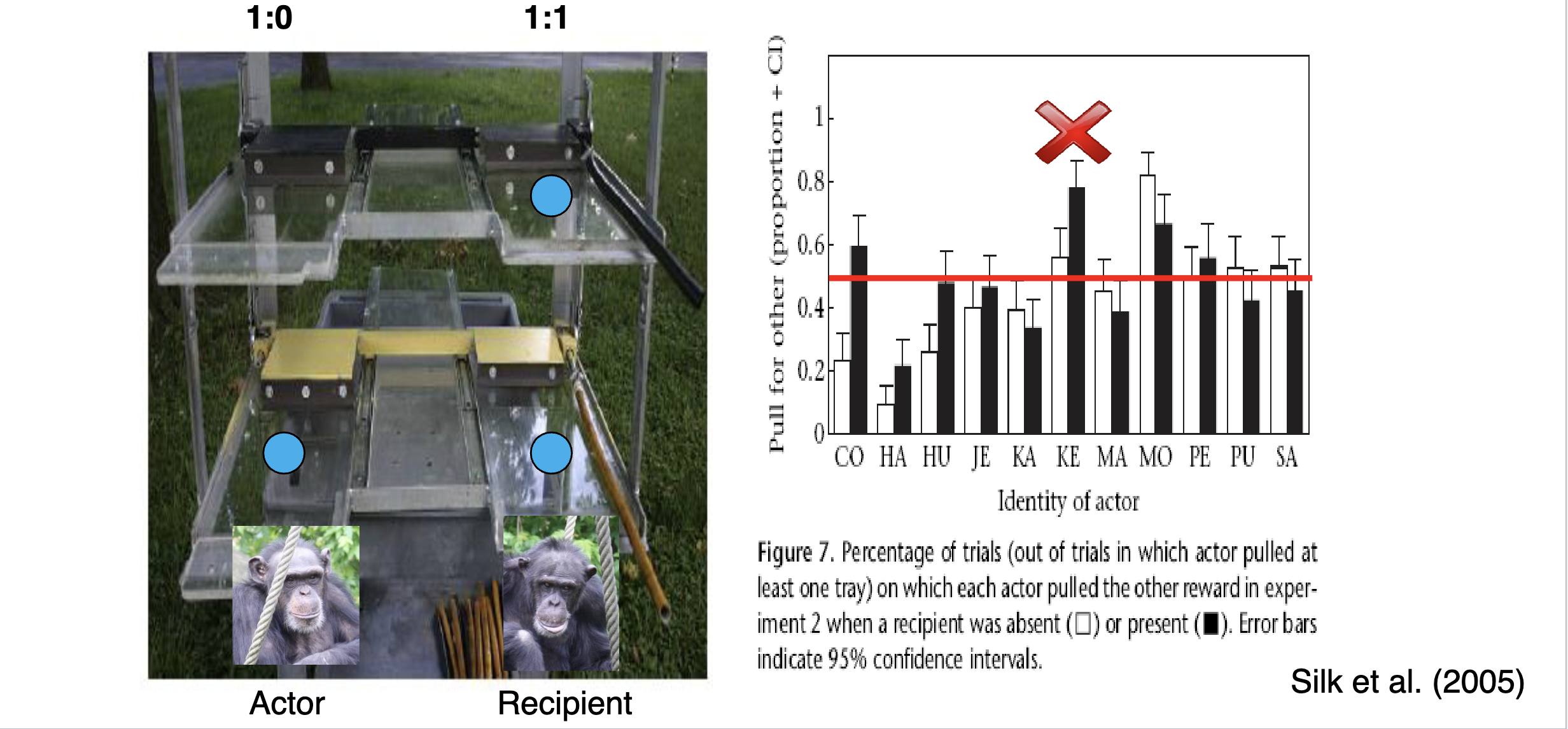
What about other species?
Inequality Aversion:
The study found that capuchin monkeys exhibited a strong aversion to inequality. In a task where two monkeys had to work together to receive a reward (such as food), they were paired with another monkey and performed the same action. However, one monkey would receive a better reward (e.g., a grape) while the other received a less preferred reward (e.g., a cucumber).
When the monkeys observed the unequal distribution of rewards, they showed clear signs of discontent and refused to participate in the task. In some cases, they even threw the cucumber back at the experimenter, expressing dissatisfaction with the unequal treatment.
Fairness and Cooperation:
The capuchins’ reactions to inequality indicate that they have a basic understanding of fairness and equity in cooperative settings. This suggests that the monkeys were motivated by a sense of fairness, rather than pure self-interest, and would engage in prosocial behavior only when the rewards were distributed equally.
However, their willingness to cooperate and engage in the task was significantly reduced when they perceived an unfair distribution of rewards, suggesting that their prosocial behavior was conditional on the fairness of the situation.
Prosocial Behavior:
The study demonstrated that while capuchins are not inherently altruistic in the sense of helping others without any personal gain, they do have an understanding of fairness and may engage in cooperative behavior if they perceive that the situation is equitable. However, they will reject situations where they feel they are being treated unfairly or where the distribution of rewards is unequal.
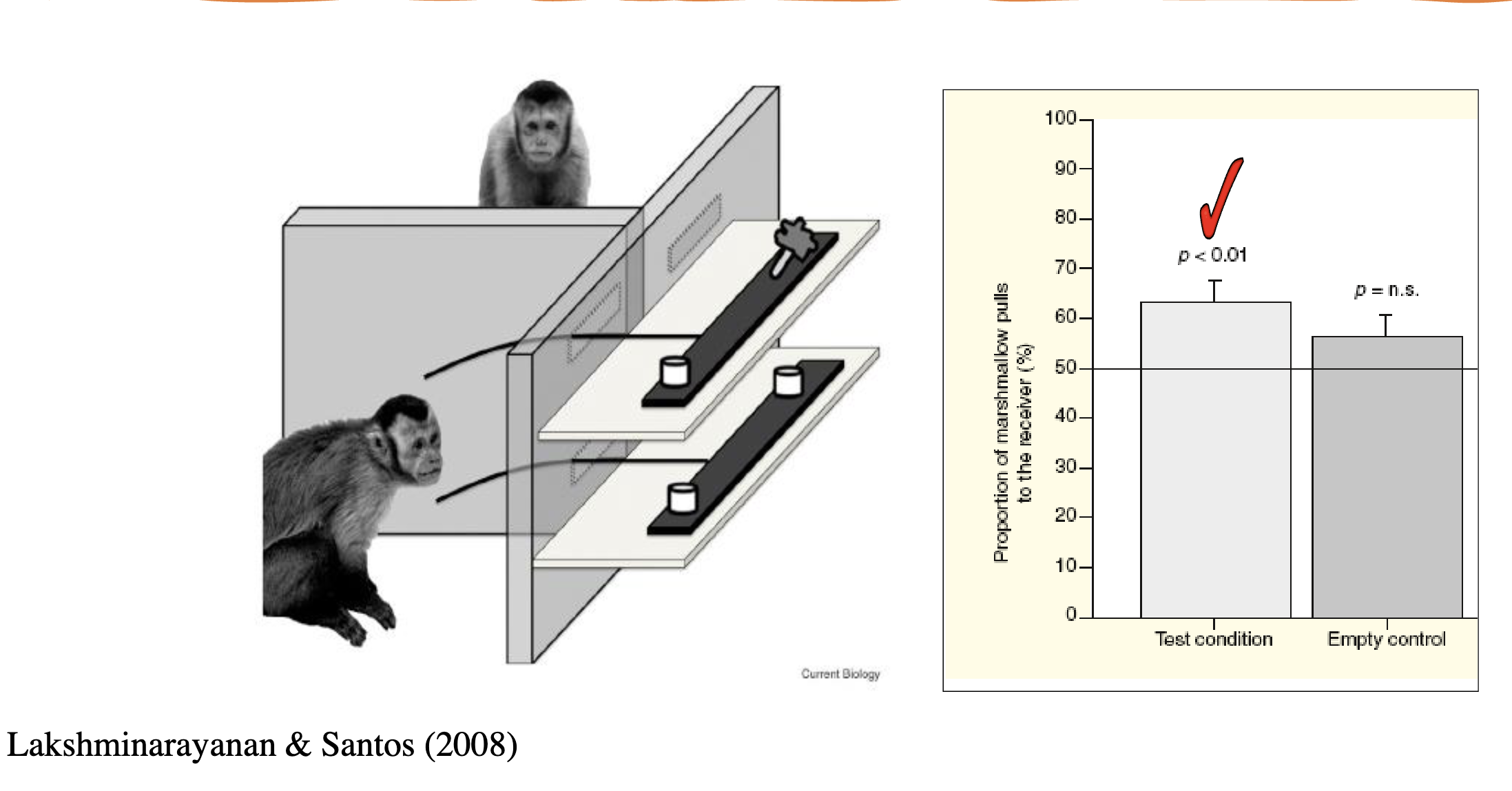
Conclusions
Young children seem to engage in prosocial behavior, such as helping from a very early age. However, when children were asked to make a forced choice decision how they will allocate resources to another individual they are often 'mean’.
It seems as though young children are fairly willing to give their partner a nice reward as long as they receive a nice reward themselves. However, young children tend to not allocate a reward to their partner when they see themselves receiving nothing. (Self interest or equality)
Reciprocity in children depends on an agent's selection and not on the value of rewards. Through experience, children learn to distribute resources more equally, which aids reciprocity, reputation, etc. These are not uniquely human characteristics as prosociality is evident in other species.
The development of moral reasoning
Moral reasoning refers to how we reason or judge whether an action is right or wrong. Piaget pioneered the cognitive development approach to the development of moral reasoning. Kohlberg has carried this tradition.
Piaget
Was interested in children’s understanding of rules, and developed his theory of moral development (the moral judgment of the child, 1932)
He studied boys playing marbles and used four methods to investigate how the rules of the game (representative of the rules of society) were acquired: He asked the children directly, he played with a child and pretended to be ignorant of the rules, he watched the children play with others, he interviewed the children.
Piaget three stages
Pre-moral judgment: up to 4-5 years old, rules were not understood.
Moral realism: from ages 4-5 and 9-10 rules were seen as as coming from a higher authority and could not be changed.
Moral subjectivism: from age 9-10, upward rules were seen as mutually agreed by people and open to change if all people agreed.
Piaget also distinguished similar stages in a girls’ game; they occurred somewhat earlier - as perhaps the game was more simple.
Criticisms of Piaget
He had small sample sizes
He measured what children said the rules of the game were, rather than how they behaved.
A lot of research conducted in the investigation of Piaget’s theory only partially supports his framework (Patanella, 2011)
There is also a lack of consideration for culture and socio-economic status in moral development.
Piaget’s theories also rely on discrete stages.
Kohlberg
His theory is used in criminology as well as psychology.
His work uses story dilemmas.
Kohlberg three levels
He hypothesized three levels of moral reasoning:
Pre-conventional (3-7 years old): Stage 1 - avoiding punishment, stage 2 - self interest.
Conventional (8-13 years old): Stage 3 - living up to what is expected of you (close relationships), stage 4 - living up to what is expected of you (law and order, society).
Post-conventional or principles (13 years old - adulthood): Stage 5 - social contract, stage 6 - principle, personal ethics.
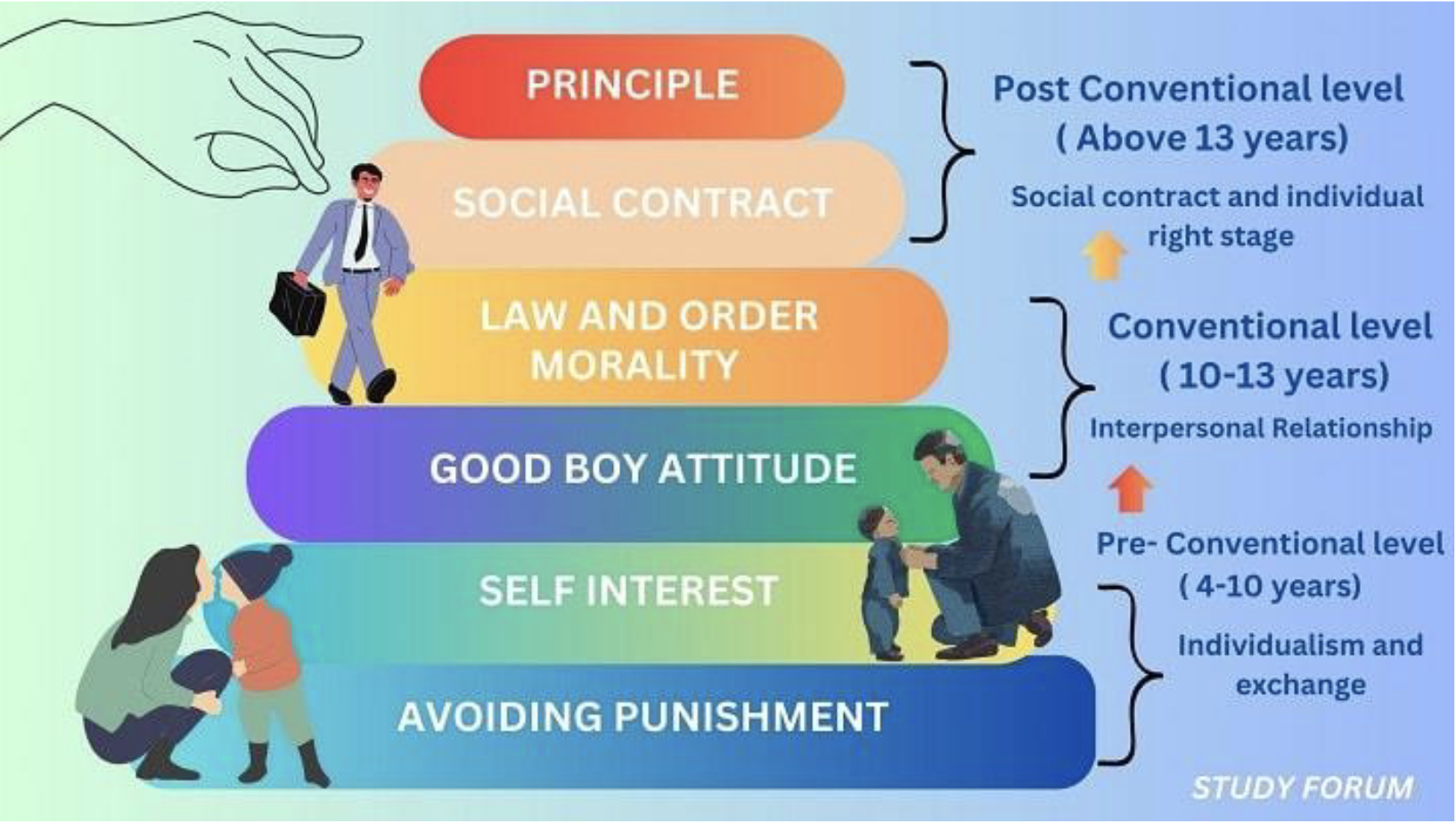
Kohlberg’s theory of moral development summary
Moral development changes over age:
People debate whether rules should be followed due to the fear of punishment, rules may be different for everyone, and some people may hold them up to fit into society, whilst others may follow rules that fit their ideas of what they have been learned throughout their entire life.
Criticism of Kohlberg’s theory
His work was mainly subjective, had mainly male participants and the dilemmas were too abstract.
Kohlberg and his co-worker revised some aspects of his theory, they found that while the stage sequence for stages 1-4 has been well supported, very few studies found true stage 5 reasoning. Kohlberg considered stage 6 to be a hypothetical stage which has to be established empirically.